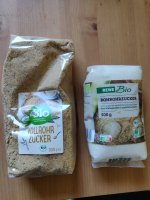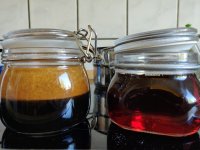Northern_Brewer
British - apparently some US company stole my name
The First Gold doesn't work, I discussed it earlier either here or elsewhere, but of course we don't all know everything everyone's posted. First Gold is somewhat unobtainable now. My LHBS is Northern Brewer or Midwest, and they've stopepd carrying it. Last time I tried it I got... rye flavors, possibly raw wheat flour. I didn't like it at all but the hops were questionable due to being fairly old and sitting outside of the frig at the store (because they were no longer going to carry them). I could try mail order but so far no one's got them (Yakima direct, Morebeer, AIH, etc.). I was planning to mix EKG and Challenger this time, but I know the challenger won't get the fruity bit but I thought it might still be a good flavor.
So I'm seeing options - mail order First Gold (to get something fresh), add invert, and keep with Pub A09 but at a lower pitch.
Solid advice, thank you.
Still open to yeast optionsI don't need orange specifically but just didn't want to go off in some other clearly non-English direction. Was still trying to choose from English yeast strains. I'll read that linked thread again. I have read through it but quite soem time ago, and I know more now than I did then and might learn something.
Sucks about First Gold across the pond. It won't help that
a) even here, there's been a big swing in fashions, retailers sell Citra and Galaxy as soon as they land in the warehouse on but trad British and Continental hops are a bit out of fashion, so stay on the shelves longer and so the quality won't be as good.
b) Covid disruptions have meant less beer being sold in pubs so again there's more inventory hanging around than there might have been
c) Covid has caused wideranging disruption to world trade, and relatively small amounts of niche products are not first in line for the limited freight capacity available
d) Brexit is continuing to screw up British trade with the rest of the world - nearly six years after the referendum we still don't have working customs software, and most of the focus is again on fixing the big trade flows with our neighbours.
None of these are the sole reasons that you're not seeing particular British hops in good condition Stateside - but none of it helps.
Personally I wouldn't get too hung up on the orange thing, it may be a Fuller's trademark but most British beer doesn't have it. If you haven't tried 1469 then that's an obvious one to start with, maybe then WLP023. And if you ever see WLP038 Manchester then that definitely seems to be worth grabbing, it's a Vault strain that almost nobody has tried - I've not got round to trying mine - but the reviews all seem pretty positive.






![Craft A Brew - Safale S-04 Dry Yeast - Fermentis - English Ale Dry Yeast - For English and American Ales and Hard Apple Ciders - Ingredients for Home Brewing - Beer Making Supplies - [1 Pack]](https://m.media-amazon.com/images/I/41fVGNh6JfL._SL500_.jpg)





















































